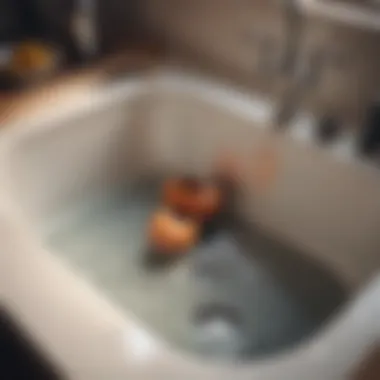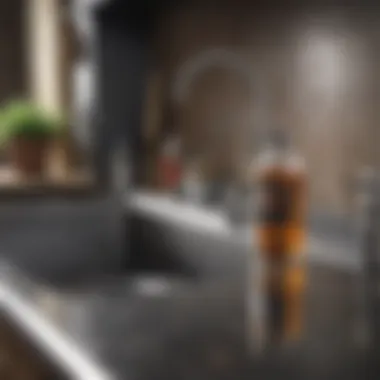Solutions for Slow Kitchen Sink Drains and Disposals


Intro
In any kitchen, slow drains and ineffective garbage disposals can create significant disruptions. Homeowners regularly encounter these problems, which are often simple in nature yet frustrating. The underlying causes vary, from grease buildup to debris lodged in pipes. A thorough understanding of these mechanics not only restores functionality but also ensures long-term efficiency.
This article thoroughly explores the factors contributing to slow kitchen sink drains and garbage disposal problems. We will discuss practical maintenance tips, identify common issues, and suggest effective solutions that anyone can implement. Additionally, preventative strategies will be highlighted, equipping homeowners with the knowledge to tackle plumbing challenges proactively.
To navigate kitchen plumbing crises effectively, one must grasp both the immediate fixes and the longer-term approach to maintenance. By addressing these concerns, fatigue and irritation caused by plumbing issues can be minimized, allowing one to focus on enjoying their kitchen space rather than worrying about ongoing problems.
Understanding Kitchen Drain Systems
Understanding kitchen drain systems is vital for homeowners who want to address issues related to slow drains and garbage disposals. A well-functioning drain system ensures that waste water exits efficiently, which is a foundation for a hygienic kitchen environment. Knowing the components and their collective role can help in diagnosing problems quickly and implementing maintenance routines that prevent costly repairs.
Components of a Kitchen Drain System
The kitchen drain system comprises several key components, each serving a specific purpose. Key parts include:
- Sink Basin: This is where water collects and is the first stage of drainage. Problems here often manifest as slow drainage or overflow.
- Drains and Pipes: These transport the waste water away from the sink towards the main drainage line. The diameter and material of the pipes can influence flow efficiency.
- P-Trap: A critical part that traps debris and prevents odors from coming back up the drain. Clogs often form in this part due to accumulated particles.
- Vent Pipes: These allow air to enter the drainage system, ensuring smooth wastewater flow. Clogged vents can lead to slow draining and gurgling noises.
Understanding these components can assist homeowners in visualizing where issues like clogs or slow drainage may arise.
Role of the Garbage Disposal
The garbage disposal unit plays a significant role in managing food waste created during meal preparation and cleanup. Its function is to grind up food scraps into smaller pieces, allowing them to flow easily through the drainage system. However, misuse or overloading of the disposal can lead to various problems such as clogs and malfunctions.
- Usage Limitations: Disposals are not designed to handle fibrous materials like celery or large bones. Knowing what can safely be processed can extend the life of the unit.
- Maintenance: Regular maintenance helps keep the garbage disposal running effectively. This can include periodic cleaning and checking for mechanical issues.
When homeowners have a grasp of how the kitchen drainage system, including the garbage disposal, operates, they can proactively address potential problems, ensuring their kitchen remains functional.
Identifying Slow Drain Issues
Identifying slow drain issues is a crucial step for any homeowner dealing with kitchen plumbing problems. Slow drains can disrupt daily activities, making the kitchen less functional and increasing the likelihood of further plumbing complications. Knowing how to detect early signs of a slow drain allows homeowners to take prompt action, potentially avoiding costly repairs in the future. It also enhances overall kitchen hygiene and reduces the chances of unpleasant odors that often accompany stagnant water.
Common Symptoms of a Slow Drain
There are several symptoms that indicate your kitchen sink may be experiencing drainage issues. Recognizing these signs early can help mitigate problems before they escalate:
- Water Stagnation: If water takes longer to flow down the drain, this is an initial warning. Observe if the water pools at the bottom of the sink.
- Unpleasant Odors: A foul smell can emanate from a slow drain due to the breakdown of organic matter. This odor may indicate that food waste is trapping in the pipes.
- Gurgling Noises: Sounds from the drains, such as gurgling, can suggest air pockets created by blockages. These sounds often precede complete clogs.
- Frequent Clogs: If you notice that your sink frequently requires plunging or cleaning, this points toward an underlying drainage issue.
When to Be Concerned
Identifying when issues become serious is essential for preventing extensive plumbing repairs. Here are key indicators to signal that you need to take action:


- Consistent Slow Draining: If the slow drainage persists despite cleaning efforts, this suggests a deeper blockage or structural issues within the plumbing.
- Water Backup: When water starts backing up into the sink or even elsewhere, it indicates a serious problem requiring immediate attention.
- Multiple Drains Affected: If the kitchen sink and other drains, like the dishwasher or the bathroom sink, are clogged simultaneously, this may indicate a significant blockage in the main drain line.
Remember: When you notice persistent issues, it is wiser to consult a professional rather than risk further damage or complications.
Causes of a Slow Kitchen Sink Drain
Understanding the causes of a slow kitchen sink drain is essential for any homeowner. It allows for proactive measures to be taken before issues escalate. By recognizing the triggers that contribute to slow drainage, individuals can avoid unnecessary inconveniences and the potential for costly repairs. A well-maintained kitchen drainage system ensures that daily tasks, such as washing dishes or preparing meals, can be performed efficiently. Furthermore, being informed about these causes can help foster better practices in kitchen hygiene, ultimately leading to longer-lasting plumbing systems.
Accumulation of Food Waste
Food waste accumulation is one of the primary reasons behind slow kitchen sink drains. Over time, food remnants can adhere to the inner walls of pipes, creating a build-up that restricts the flow of water. This issue is exacerbated when larger food particles are sent down the drain without using a garbage disposal or when improper disposal methods are employed.
Regularly using a garbage disposal does help, but it is not foolproof. Homeowners should be mindful of what they allow down the drain. Items such as fibrous vegetables, meat scraps, and starches can contribute significantly to drain blockages. Adopting waste disposal habits that reduce the risk of accumulation, such as composting or disposing of food scraps in the trash, can prove beneficial in minimizing slow drain issues.
Clogs from Grease and Soap Scum
Grease and soap scum form another major contributor to slow kitchen sink drains. Cooking oil, fats, and soap residues can solidify within the piping system. This creates a sticky paste that attracts other debris, further compounding the clogged issue. Homeowners who frequently cook with oil-rich ingredients may observe this problem more intensely.
Clearing out grease from pans before washing them can help maintain drainage flow. Additionally, using hot water to wash dishes periodically can soften and dissolve some buildup. Simple practices like these reduce the risk of clogs formed by greasy substances.
Pipe Blockages and Damage
Pipe blockages and damage encompass a range of plumbing issues, including the constriction caused by foreign objects or even aging pipes. Over time, pipes can corrode or become misaligned, leading to significant drainage issues.
If a blockage is suspected, it is critical to visually inspect visible pipe areas for any signs of leaks or damage. Using a drain snake or liquid drain cleaner may alleviate minor blockages, yet persistent issues warrant professional assistance. Delaying necessary repairs can lead to larger, more invasive problems in the future, resulting in costly repairs and home disruptions.
Maintenance Tips for Kitchen Drains
Maintaining kitchen drains is essential for preventing slow drainage issues and ensuring the efficient function of garbage disposals. Regular care can help avoid costly repairs and preserve the integrity of the entire plumbing system. By incorporating maintenance tips into your routine, you contribute significantly to an overall smoother kitchen experience. This section outlines practical methods to keep your kitchen drains and disposal units in optimal condition.
Regular Cleaning Methods
Regular cleaning of kitchen drains should be a staple in any household maintenance checklist. This process removes debris, food particles, and other build-up that could lead to blockages. It is essential to understand that, over time, sediments can accumulate and hinder drainage efficiency.
Some effective cleaning methods include:
- Using a Plumber’s Snake: This tool allows you to reach deep into the pipes to clear away stubborn clogs. It works effectively on hair, grease, and deeper blockages that regular cleaning might miss.
- Hot Water Flushes: Pouring boiling water down the drain can help dissolve grease and fats. Regular application can drastically improve the flow of water through pipes.
- Commercial Drain Cleaners: Occasionally using enzyme-based commercial drain cleaners can help break down organic matter. Choose products designed for kitchen use to avoid damaging your plumbing.
In addition, routine inspection of drain covers and disposal units can further prevent clogs and blockages.
Using Baking Soda and Vinegar
An eco-friendly and cost-effective cleaning method involves using baking soda and vinegar. This combination is not only effective but also gentle on your plumbing system.


To use this method:
- Clear the Drain: Start by removing any visible debris from the drain.
- Add Baking Soda: Pour half a cup of baking soda directly into the drain. This will help absorb odors and begin breaking down build-up.
- Add Vinegar: Follow with half a cup of vinegar. You might notice bubbling reactions; this is normal and indicates that the solution is working to dislodge any minor clogs.
- Let It Sit: Allow the mixture to sit for about 30 minutes to an hour. This gives it time to penetrate any build-up in the pipes.
- Rinse with Hot Water: After the waiting period, flush the drain with hot water to clear out any remaining debris.
This approach not only helps maintain clear drains but also keeps them smelling fresh. Incorporating this treatment regularly ensures that your kitchen sinks function optimally and are less prone to clogs.
Troubleshooting Garbage Disposal Issues
When discussing kitchen plumbing, troubleshooting garbage disposals emerges as a vital aspect. These units help manage food waste efficiently but can encounter many problems. Being able to identify and rectify these issues ensures the kitchen runs effectively, minimizing mess and time spent on repairs. More importantly, understanding garbage disposal issues can prevent potential damage to the system, saving homeowners from costly repairs or replacements later on.
Common Garbage Disposal Problems
Several frequent issues exist with garbage disposals. Recognizing these problems early can prevent further complications:
- Jamming: Overloading the disposal or introducing hard items like bones can cause jams. Jammed disposal units often make a humming noise without grinding.
- Leaking: Check for leaks around the unit's mounts or drains. Leaks can occur due to worn seals or improper installation.
- Odors: Bad smells usually stem from trapped food waste. Regular cleaning prevents this issue.
- No Power: Some disposals may stop working due to blown fuses or tripped circuit breakers.
Engaging with these problems promptly can maintain efficiency in kitchen tasks and prevent bigger disruptions.
Resetting the Disposal Unit
A common solution for troubleshooting a garbage disposal is resetting the unit. Most disposals have a reset button located on the bottom, often red. Here are the steps to reset your garbage disposal:
- Turn Off the Power: For safety, ensure the disposal is powered off, either at the switch or by unplugging it.
- Check for Jams: Before pressing the reset button, use an Allen wrench to manually turn the blades from under the disposal to dislodge any jammed material.
- Press the Reset Button: Locate the reset button; a single press may resolve the issue. If the button doesn't stay in, it indicates ongoing problems.
- Restore Power: Once reset, turn the power back on and run water through the disposal to test functionality.
While resetting doesn’t fix all issues, it can resolve minor ones quickly.
By understanding common issues and resetting the unit as needed, homeowners can keep their garbage disposals functioning well.
Preventative Measures for Kitchen Drains
In the realm of kitchen plumbing, preventative measures are essential to maintain the functionality of drains and garbage disposals. By adopting proactive strategies, homeowners can avoid unpleasant clogs and costly repairs, ultimately ensuring a smoother culinary experience. Preventative maintenance not only preserves the lifespan of plumbing systems, but it also enhances the efficiency of kitchen activities.
Understanding Disposal Limitations
Garbage disposals serve a valuable function in modern kitchens, but they have their limitations. It is crucial to know what items can safely enter this unit to prevent damage and clogs. Common items to avoid include:
- Fibrous materials: Items like celery or corn husks can wrap around the blades and cause blockages.
- Starchy foods: Foods such as potato peels can congeal and form pastes within pipes.
- Grease: Oils and fats solidify as they cool, leading to significant blockages.
- Hard materials: Bones or large fruit pits can break the disposal's blades or jams it completely.
Following these guidelines helps homeowners maximize the effectiveness of their garbage disposal and minimizes the need for repairs or replacements.
Educating Household Members


Another significant step in preventative care for kitchen drains is educating all household members about proper usage. Awareness can mitigate many issues and reinforce good practices:
- Teach what to avoid putting down the drain: Make sure everyone knows which foods or materials damage the system.
- Promote regular cleaning: Encourage scheduled maintenance cleanings with simple methods such as flushing with hot water or using baking soda and vinegar.
- Instill good habits: Use strainers in sinks to catch food particles, and remind family members to dispose of food waste appropriately.
By fostering a culture of awareness regarding kitchen drainage practices, households can effectively reduce the likelihood of plumbing issues, making for a more efficient kitchen environment.
"An ounce of prevention is worth a pound of cure" - Benjamin Franklin, highlighting the importance of preventive measures.
Implementing these practices creates not just a cleaner kitchen but also reinforces the longevity and functionality of plumbing systems.
When to Call a Professional
In addressing problems with slow kitchen drains and garbage disposals, knowing when to call a professional is crucial. Many homeowners attempt DIY fixes, which can sometimes lead to more significant problems. Understanding the limits of self-service can save time, efforts, and even money in the long run. Key indicators exist that suggest it may be time to consult a professional plumber.
Important: Ignoring severe plumbing issues can lead to more extensive damage over time, compounding repairs and increasing costs.
Recognizing Serious Issues
Some symptoms indicate serious plumbing problems requiring professional intervention. Signs such as water backups, unpleasant odors emanating from the sink, persistent clogging, or noisy garbage disposal should not be ignored.
Additionally, if the water drains backward into a different sink or the toilet, this signals a significant blockage or plumbing issue further down the line. These issues implicate not just the visible plumbing but often imply underlying system failures that could escalate if not addressed.
When faced with these problems, it's wise to stop the DIY attempts to clear the drain and to consult a qualified plumber.
Choosing the Right Plumber
Selecting the right plumber can be crucial in resolving slow drain issues effectively. Consider professionals with good reviews and appropriate licenses. Here are some points to think about when defining your choice:
- Experience: A plumber with a solid track record and experience in specific plumbing issues, like garbage disposals.
- Certification: Ensure they have the necessary certifications for the work they will perform.
- Local Knowledge: A plumber familiar with local plumbing regulations may help ease the process and prevent future issues.
- Quotes and Transparency: Request quotes from multiple plumbers and assess their transparency regarding services offered.
Taking time to choose the right professional can lead to a quicker resolution of your issues and long-term benefits for the plumbing system.
Epilogue
Summary of Key Points
In summarizing, several crucial aspects have been discussed:
- Understanding Drain Systems: The importance of familiarizing oneself with kitchen drain components and the role of garbage disposals can aid homeowners in diagnosing potential issues.
- Identifying Slow Drains: Recognizing early symptoms of slow drains ensures proactive measures can be taken, preventing significant disruptions.
- Causes of Slow Drains: Knowing the common causes of these issues, such as food waste accumulation and grease build-up, is essential for effective management.
- Maintenance Tips: Implementing regular cleaning practices, including the use of baking soda and vinegar, can help maintain drain efficiency.
- Troubleshooting and Prevention: Understanding when to tackle problems independently and when to seek professional assistance guides homeowners in making informed decisions.
Final Recommendations
As a final note, homeowners should consider the following recommendations:
- Regular Inspections: Conduct periodic checks of your kitchen drain systems to identify minor issues before they escalate.
- Educate Family Members: Ensure that everyone using the kitchen is aware of what can and cannot be disposed of through the sink and garbage disposal.
- Utilize Professional Services: Do not hesitate to contact a licensed plumber when facing persistent issues. Selecting a qualified professional ensures that jobs are executed correctly and safely.
- Stay Informed: Keep up with new maintenance techniques and technologies in plumbing. Engaging with resources like Reddit or skilled professionals can enhance your knowledge and preventative efforts.
"Effective management of your kitchen drains is not simply about solving problems; it's about preventing them and creating a seamless kitchen experience."
By following the insights and guidance presented throughout this article, homeowners can maintain their kitchen systems effectively and enjoy a hassle-free kitchen environment.















